Break your monolith into microservices, and you’ll unlock agility, speed, and scalability.
This idea has been widely promoted by tech giants, cloud providers, and world-known companies’ blogs describing their “happy ending” of moving from outdated monoliths to modern microservices.
And indeed, statistics show that microservices adoption is spreading and will further increase from today’s $7.45 billion to $15.97 billion in just four years.

But are microservices always the right choice, as many claim? As the popular idiom goes, what works for one may not work for another.
We’re not going to glorify microservices or dismiss monoliths, and vice versa. Instead, we’ll try to find the right solution for you if you are starting a new project or thinking about improving your monolithic system.

Contents
- Monoliths: Key Characteristics, Pros & Cons
- Microservices: Key Characteristics, Pros & Cons
- Why Do Companies Switch From Monolithic to Microservices Architecture?
- When to Choose Monolith or Microservices for the Long Run
- Is Microservices Architecture Better Than Monolithic in 2025 and Beyond?
- Summing Up
In the early 2010s, the push to enhance everyday life through online services sparked the adoption of service-oriented architecture (SOA). This marked the beginning of the shift from monolithic architectures to microservices.
Several global companies, starting with pioneers like Netflix, successfully moved to the new architecture. Later others, like Uber, Spotify, eBay, and X (formerly Twitter), followed them.
However, the experience of Amazon Prime Video showed another story.
In short, Amazon developers abandoned their microservices-based monitoring system and returned to a monolith, cutting infrastructure costs by 90% while improving scalability. Their mistake was in following a microservices approach but not accounting enough for their specific needs, which resulted in much more complexity and expenses.
This story led us to our engineering department for some insights about the real state of the market beyond the statistics, big brands, and enterprise-scale case studies.
We’ll be sharing thoughts of our tech leads as we thoroughly explore what monoliths and microservices really are.
Monoliths: Key Characteristics, Pros & Cons
Every project, from tiny startups to industry giants, took their first digital steps as simple monolithic applications. This architectural pattern was the natural starting point that helped countless successful products sprint from idea to launch.
What Is a Monolith?
A monolithic application is a single, unified software system where all components, such as the user interface, business logic, and database interactions, are tightly connected and operate as one unit. Everything is stored in one codebase, deployed as a single package, and runs as a single process.
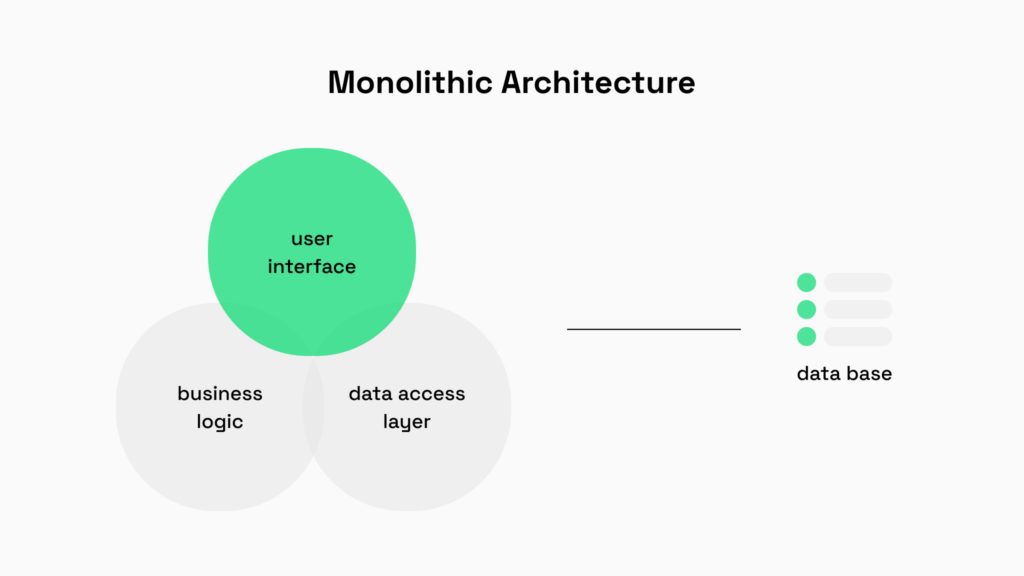
It’s like a restaurant kitchen where everyone, including the administrator, the waiters, the head chef, the cooks, and the cashier, works in perfect sync. No runners or phones are needed. Every tool, every person, every function is just an arm’s reach away.
So what makes a monolith a monolith? Let’s see.
Key Characteristics
Single Codebase & Deployment
A monolith is like a self-contained digital fortress where your code, features, and dependencies all live together. And when it’s time for an upgrade? One is enough. No complicated deployment choreography is needed, though larger monoliths need more careful planning and testing to ensure everything updates smoothly.
Simple Communication
The superpower of a monolith is its ability to interact with others directly. Instead of jumping through network hurdles, each component of your program communicates internally with functions and modules. Fast and dependable, with no intermediaries necessary.
Easy Debugging & Testing
As everything lives under one roof, troubleshooting is easier. Developers can trace issues without having to check multiple services, logs, or network requests. Testing is also more straightforward since there’s only one application to test.
Centralized Data Operations
One database powers all operations in a monolith, eliminating sync headaches and keeping data consistent across the board.
Simplified Development Journey
Monoliths keep development clear and direct. With everything consolidated in one place, teams skip the complexity of distributed architectures and focus on building features.
Pros & Cons
| Pros | Cons |
| Quicker to build, easier to manage, and simpler to launch. | As the app gets bigger, the code can become tangled and difficult to manage. |
| Having all logs and errors in one system makes testing and debugging easier. | To scale, you must improve the performance of the entire application, not just its busy parts. |
| A unified codebase allows for smoother collaboration among team members. | As the project grows, a large team sharing one codebase is more likely to face integration issues. |
| Better performance (initially). No API calls between services, just direct function calls. | The build and deployment time grows in proportion to the size of the project. |
| Data consistency is simpler when everything shares a database. | If one part crashes, often the whole system goes down. |
Monoliths have stood the test of time for a reason. They contribute to your business strategy and help you meet your goals with minimal complexity both when you start and during early growth. However, as businesses continue to scale, challenges can arise and lead to exploring alternatives like microservices.
Some businesses weigh all the pros, cons, and opportunities and start a complicated transition to microservices. Others choose to keep their original monolithic architecture but grow in a different way.
Let’s explore some examples.
Monolith Use Cases
Shopify powers millions of online shops worldwide. An interesting fact about them is that they began their core system as a monolith built with Ruby on Rails. And even when they decided to scale by building microservices like checkout and fraud detection, they still kept their monolith. The main thing they did was restructuring the architecture and creating a “modular monolith” for better maintenance.

GitHub is another monolithic case. Despite hosting code for practically every major software project on the planet, their main application began and largely remains a Ruby on Rails monolith. Instead of ditching their foundation, they thoughtfully extended it, building specialized services for high-demand features like notifications and Git storage while preserving the cohesive experience developers love.
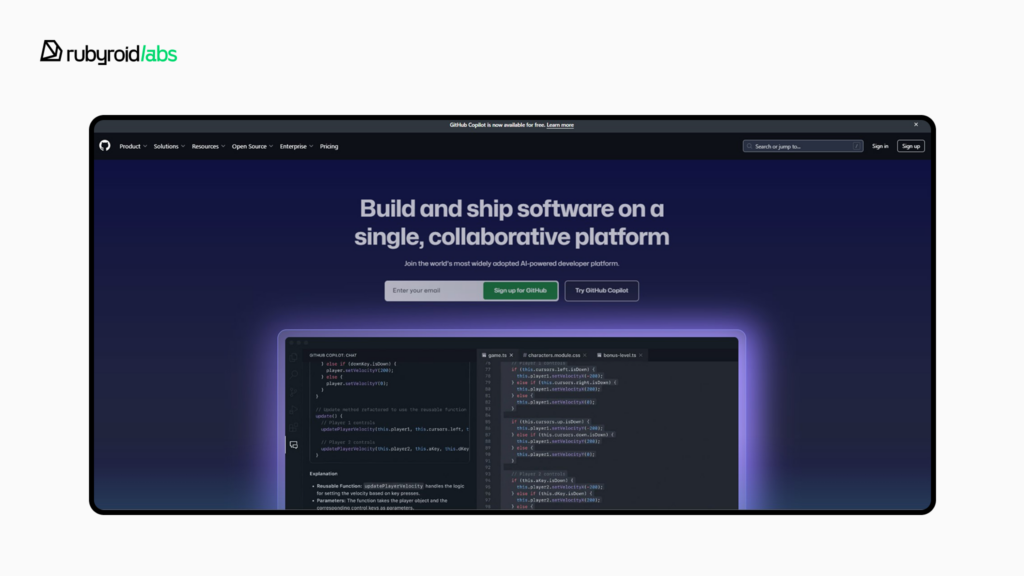
Years ago, Zeitview (formerly DroneBase) started with a Ruby on Rails monolith, offering drone-based inspections for renewable energy and real estate sectors. Today, despite expanding to over 60 countries, they haven’t abandoned their monolith for a complete microservices rebuild. Instead, Zeitview chose to enhance their core monolith and strategically extract microservices where needed. For example, they built a dedicated service for processing the massive amounts of images and videos collected during drone inspections.

After all these use cases of monoliths among world-known companies, there arises a logical question: if everything can run smoothly on monoliths, what’s the purpose of microservices then? Why is this architecture type promoted as problem-solving?
Let’s find the answers in the next chapter.
Microservices: Key Characteristics, Pros & Cons
The core idea behind microservices you need to grasp is that they are used mostly by enterprises and companies with heavy traffic every day. The real need to adopt microservices often comes with significant technical challenges or the specific business area that demands specific business-critical components that need independent scaling or frequent updates.
What Are Microservices?
Microservices is all about splitting an application into a network of small, self-contained services. Each of them is focused on their own business task. Think of it like a vibrant city block where instead of one giant building doing everything, you’ve got a bakery, a bike shop, a post office, and a café, each working independently, built with different tools, but all working together to serve the neighborhood.
Each service can be created and launched separately, even in different languages or tech stacks. They talk to each other over a network, usually through APIs, coordinating like good neighbors to keep the whole system stable and responsive.
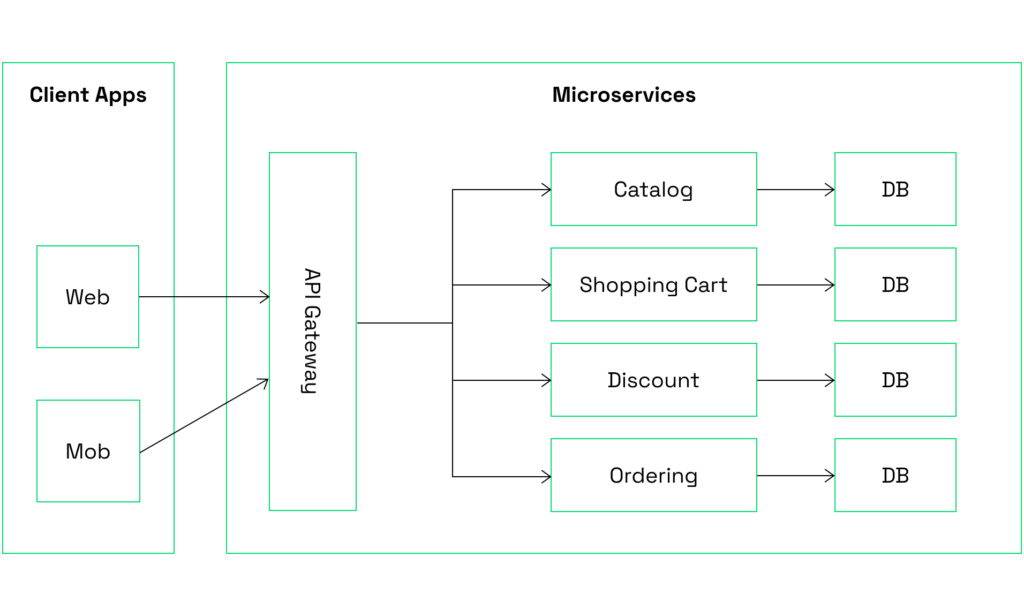
Key Characteristics of Microservices
Independent Operational Units
Microservices work independently of one another, each maintaining exclusive control over its code repository, database architecture, and core business operations. This deliberate separation empowers teams to move at their own velocity, shipping features and fixes without the traditional coordination overhead of intertwined systems.
Streamlined Delivery
Development teams operate in parallel lanes, each owning and evolving distinct application components without synchronization delays. That means features get built quicker, and updates can go live without touching the whole system.
Each Service Handles Its Own Data
Rather than sharing one big database, each microservice keeps track of its own information. This helps avoid bottlenecks and makes things run more smoothly.
Flexible Scalability
As microservices run on their own, you can boost just the parts that are getting busy. For example, if your payment system is handling a lot of traffic, you can scale it up without touching the rest of your app.
Higher Complexity
Microservices give flexibility, but they also add some extra moving parts. With many services running at once, they demand a strong DevOps team, tools, and practices to keep everything working smoothly, catch issues early, and make sure all the pieces stay connected.
Pros & Cons
| Pros | Cons |
| Busy services can be scaled without wasting resources on idle ones. | Requires advanced DevOps teams, regular monitoring, more deployment pipelines, and sophisticated infrastructure management. |
| Teams can work on different things at once, so important features can be launched faster without delays. | Cross-service debugging can be like solving a complex puzzle where pieces are scattered across different rooms. |
| If one service has a problem, it won’t crash the whole system. | The more services you have, the more servers, databases, and upkeep you’ll need. |
| Teams maximize efficiency by matching technologies to tasks, driving innovation through specialized tools rather than universal compromises. | Services working over a network introduce new points of failure. |
| By developing a new project or a startup with microservices, you also start solving distributed system complexities from day one. |
When we talked with our tech team about microservices, they mentioned that it’s rare to see a system built as pure microservices from the very beginning. This is because maintaining such an architecture requires a lot of investment, including things like:
- Changing how your business works and train your team in new ways.
- Building or hiring a DevOps team to keep things running smoothly.
- On top of that, expect higher server and infrastructure costs.
…and that’s just only the beginning.
Yes, microservices help the project to grow and scale, easily adjust to new needs, and enable developers to build new features faster. They can be very useful, especially for large companies that really need them.
But as for startups or medium-sized businesses, there’s often too little practical value in building such a complex infrastructure from scratch.
Let’s take a look at some real-world cases where microservices really helped.
Microservices Use Cases
Atlassian’s famous products, Jira and Confluence, were initially built as on-premise monoliths and were not that easy to scale. As the demand grew and user numbers skyrocketed, scaling those monoliths became a serious challenge. So, Atlassian chose to break down their monolithic architecture into a network of microservices. The shift spanned two years and included the migration of over 100,000 customers. Today, the organization relies on over 1,300 microservices, allowing for faster deployments and better team autonomy.
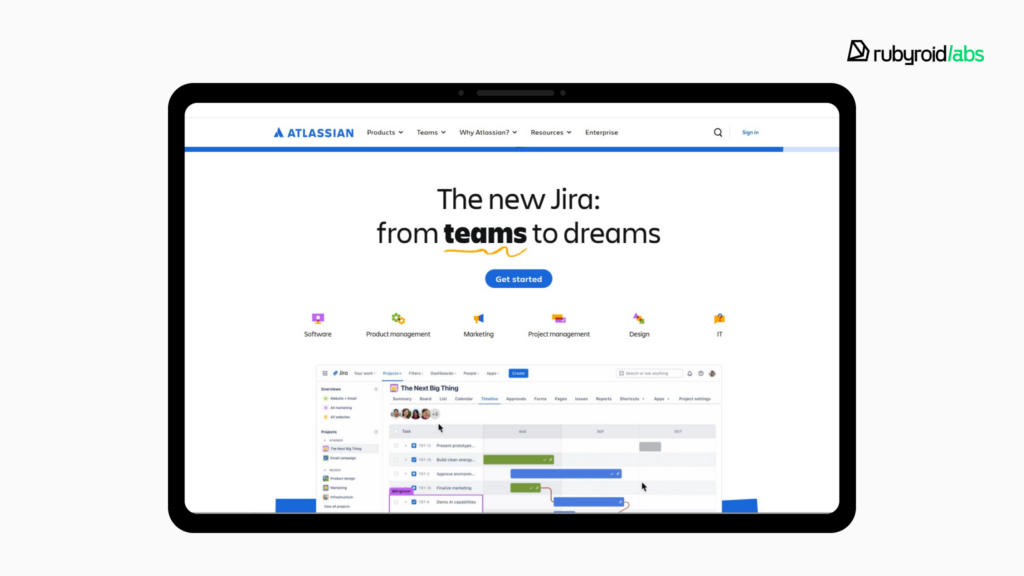
Airbnb also started as a Ruby-on-Rails-based monolith. It worked well in the beginning, helping them move fast and launch quickly. But as the company grew, that setup started to cause problems as it slowed down deployments, made it harder for teams to work independently, and created challenges when bringing on new engineers.
To fix this, Airbnb didn’t try to rebuild everything at once. They started breaking off key parts of the system like payments, search, and messaging, into microservices. They took it step by step, only creating new services when it really made sense.

Both cases show that the transition to microservices requires significant effort, expertise, and time. Another important point is that the specific industry requirements and user flow patterns were the key reasons to start that difficult process.
If you’re looking for a team to build either a monolithic or microservices architecture for your project, we have the practical experience and technical expertise to support you. We can provide consultation, project estimation and planning, and start the development process as soon as you need. Tell us your needs, and we’ll help enhance your idea with the right technologies and bring it to your users.
Why Do Companies Switch From Monolithic to Microservices Architecture?
We already mentioned that someday a monolithic application reaches the point when it needs further growth but technically it becomes hard. As the codebase grows larger and parts of the application become tightly connected, making changes, updates, or building new features becomes more difficult and risky. Developers need to understand how their changes might affect other, unrelated modules.
So, the idea of switching to microservices starts to seem like the best move. At this moment of standing at the crossroads, you ultimately need good professional advice that would give you answers for further decisions. And here is what Ilya, our VP of Engineering, has shared on this point.

The decision to migrate from monolithic to microservices architecture should be driven by your specific business needs rather than following industry trends. As Ilya pointed out, a pragmatic hybrid approach is often the best balance for addressing technical challenges and managing transition costs.
When to Choose Monolith or Microservices for the Long Run
So, monolith or microservices? The answer depends on your project’s context, team, goals, and future scalability. Here’s a quick guide to help you decide:
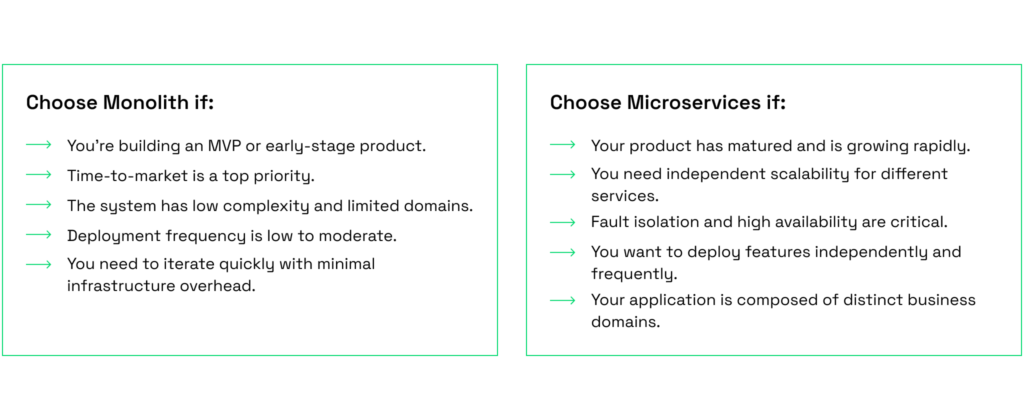
Monolithic vs. Microservices Comparison: A Side-by-Side Analysis
| Criteria | Monolithic Architecture | Microservices Architecture |
| Structure | Single source and release bundle | Multiple independent services |
| Team Size Suitability | Minimal | Expanded teams |
| Development Speed | Fast at the beginning | Slower at start, faster at scale |
| Deployment | One unit, deployed together | Independent deployments per service |
| Scalability | Requires scaling the whole application | Enables scaling of specific functionalities |
| Maintainability | Harder as the codebase grows | Easier with clear service boundaries |
| Localized failure handling | Failures can cascade across the whole system | System remains functional despite localized failures |
| Technology Stack | Generally consistent across the app | Can vary per service |
| Testing | Easier with unified testing | More complex, requires contract and integration testing |
| Infrastructure Overhead | Minimal | High (requires orchestration, monitoring, CI/CD, etc.) |
| Best Use Case | MVPs, simple or early-stage applications | Large-scale, complex, evolving systems |
Is Microservices Architecture Better Than Monolithic in 2025 and Beyond?
Our tech leads prefer not to compare the two architectures to define which is “better.”
“Monoliths and microservices aren’t competitors. They often coexist. Many companies start with a monolithic architecture and then gradually extract microservices where needed. This hybrid approach is becoming more common, as it balances simplicity with scalability.
So, it’s incorrect to say that microservices are better than monoliths, or vice versa. It’s really about picking the approach that helps you build something that works well and is easy to keep running without turning development into a headache.” – says Ilya.
Microservices or Monolith: What should I choose for my project?
Our developers agree that starting with a monolith makes more sense for new projects unless you have specific high-load requirements from day one. It’s like building a house: you start with a solid foundation before thinking about adding separate structures.
In any other case, our general recommendation is:
- Start with a well-structured monolith.
- Identify bottlenecks and high-load areas.
- Gradually extract specific functionalities into microservices where it makes sense.
- Maintain both systems working together harmoniously.
Looking at 2025 and beyond, although we can see the rising use of microservices, our own practice and real-world experience tell a slightly different story. We’re seeing that project owners increasingly prefer “smart hybrids,” which are the systems that combine the best of both worlds.
The future isn’t about choosing one architecture over the other but about building systems that can adapt and scale efficiently while remaining maintainable and cost-effective.
The key is understanding your specific needs and choosing the right approach (or combination of them) for your situation.
Summing Up
When choosing an architecture type for your system or app, you need to weigh many factors but keep in mind that your individual case is unique. That’s why it’s always a good idea to talk to someone with real experience before locking in your decision. It can save you time, money, and a lot of headaches down the road.
If you share your idea with us, our tech leads, each with 10+ years of hands-on experience working with both monoliths and microservices, can help you figure out the best path forward.
Microservices are definitely trending due to the fact that the digital world of products and services is also growing. But just because the big players are using them doesn’t mean they’re the right move for you.
The best decision comes after you analyze your project size, your team’s skill set, and where you want to go in the long run.
Here’s a quick way to look at it. If you have:
- a startup or a new project, start with a monolith. It’s faster, easier, and helps you validate your idea without overcomplicating things.
- a growing monolith application, then make a transition to microservices step by step. Identify performance bottlenecks and migrate them into independent services when necessary.
- a massive, high-traffic system in industries such as finance, e-commerce, or telecom, microservices might be the way to go. Just make sure you talk it through with someone who knows the ropes before diving in.
In the end, architecture is a tool and not a trend. The goal is to build something scalable, maintainable, and tailored to your business.




